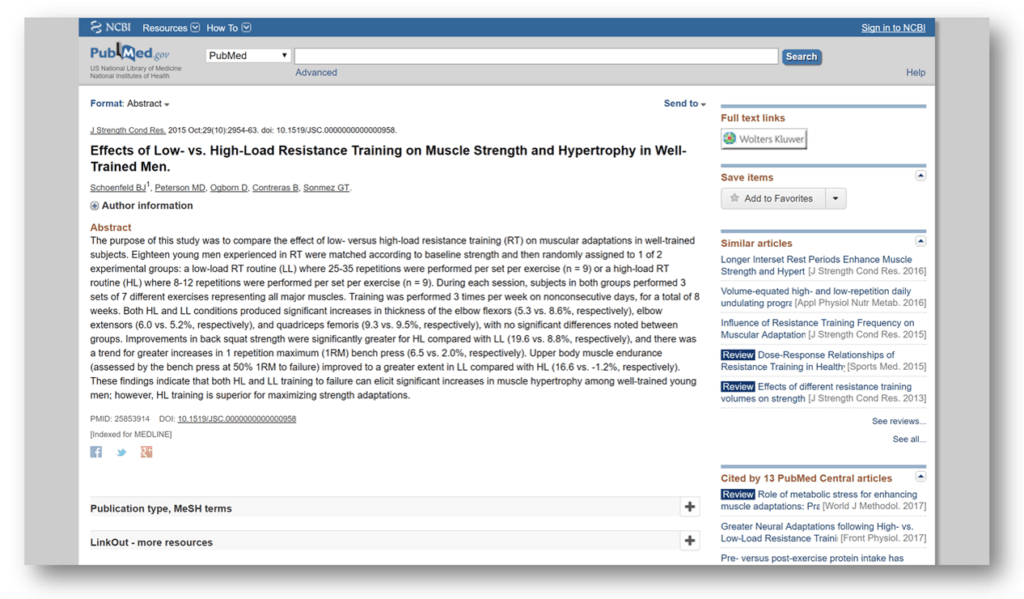先日、S&Cコーチの久保さんが、ざっくりした論文の読み方を更新してくれていました。
3分でわかる、超ざっくりした論文解説第二弾をSGにて更新しました。
「論文を読んでみよう 項目編」https://t.co/ieDtvhhN8g— のぶなが (@smalldoemu) 2017年7月31日
論文はある程度、構成が決まっていて、一般的に以下のような項目が挙げられます。
- Title タイトル
- Authors 著者
- Abstract 要約
- Introduction 研究の前提となる背景や、先行研究の紹介、問題提起、そして本研究の目的で締めくくられる。
- Methods 被験者情報や、実験に必要な具体的な情報が網羅されている。
- Results 実験の結果が羅列されている。この部分は客観的な事実。図表は著者らが特に強調したい内容。
- Discussion 結果に対する考察。なぜ、その結果が生じたかの仮説や研究の問題点についても言及される。
- Conclusion まとめ。著者らが主張したいことが、端的に述べられている。
- Reference 参考文献
論文の各項目について、もっと具体的に書いてくれているのが、先ほどの久保さんの記事
関連する部分についてまとめてあるのが、佐々部さんのこちらの記事
論文を活用するために読んでおくべきなのは、河森さんのこちらのスライド資料とブログ記事
今回は、上記の先行記事の穴を埋める、さらに入門編の内容として、アブストラクト(要約)の読み方について、まとめておきたいと思います。
アブストラクトの読み方
第一印象は「読みづらい」でも大丈夫
論文のページを表示すると、だいたいこのような感じでアブストラクトが表示されます。慣れないうちは、「うわー…英語でごちゃごちゃ書いてある」という印象を抱くのではないでしょうか。項目ごとに分けて書かれてあるものもありますが、この画像のようにひとまとめになっている場合も少なくありません。
以下に、要約文だけを抜き出しました。これだと確かに、拒否反応を示してしまう気持ちもわかります。
Abstract
The purpose of this study was to compare the effect of low- versus high-load resistance training (RT) on muscular adaptations in well-trained subjects. Eighteen young men experienced in RT were matched according to baseline strength and then randomly assigned to 1 of 2 experimental groups: a low-load RT routine (LL) where 25-35 repetitions were performed per set per exercise (n = 9) or a high-load RT routine (HL) where 8-12 repetitions were performed per set per exercise (n = 9). During each session, subjects in both groups performed 3 sets of 7 different exercises representing all major muscles. Training was performed 3 times per week on nonconsecutive days, for a total of 8 weeks. Both HL and LL conditions produced significant increases in thickness of the elbow flexors (5.3 vs. 8.6%, respectively), elbow extensors (6.0 vs. 5.2%, respectively), and quadriceps femoris (9.3 vs. 9.5%, respectively), with no significant differences noted between groups. Improvements in back squat strength were significantly greater for HL compared with LL (19.6 vs. 8.8%, respectively), and there was a trend for greater increases in 1 repetition maximum (1RM) bench press (6.5 vs. 2.0%, respectively). Upper body muscle endurance (assessed by the bench press at 50% 1RM to failure) improved to a greater extent in LL compared with HL (16.6 vs. -1.2%, respectively). These findings indicate that both HL and LL training to failure can elicit significant increases in muscle hypertrophy among well-trained young men; however, HL training is superior for maximizing strength adaptations.
しかし、アブストラクトのパターンを把握してしまえば、英語が苦手でもごちゃごちゃしていた英文に区切りが見えるようになってきます。
英語を読まなくても区切りは見つけられる
やや乱暴なやり方かもしれませんが、英文を読まずに区切りを見つける方法です。それは各項目の目印となるワードをピックアップすることで、どこに何が書いてあるかを判断するやり方です。
目印となる定型語を探す
以下が、目印となるワードの一例です。
Introduction:研究背景・目的 目印となる定型語が存在します。This study was designed to investigate …,The purpose of this study …,In this paper, …,などのフレーズが出てきたら、その文が研究目的を記述している箇所です。
Methods:実験方法 被験者の情報やグループ分け、介入内容などがシンプルに書かれてあります。young menとかolder womenとか人を表す単語が出てきたら被験者情報だと思ってください。そのほか”n=〇”という被験者の数を表す記述が出てきたり、groupsという単語が含まれているのを見れば、「この部分はMethodsだ」と認識しやすいと思います。
Result:結果 結果の記述に入ると、significant(有意な)、increase(増える)、decrease(減る)という単語であったり、±・%などの記号が出てくるようになります。データを示す箇所でもあるので、必然的に数字も混ざってきます。文章中に( )が割り込んできていて、最初は読みづらさを感じるかもしれませんが、落ち着いて区別すれば難しくありません。ここは淡々と結果が羅列されているところです。
Conclusion:結論 ここも目印となる定型語が存在します。In conclusion, …,These results suggest that …,We conclude that …,These findings indicate that …,このようなフレーズが出てくると、それ以降が著者らが主張したい結論です。
Abstract
The purpose of this study was to compare the effect of low- versus high-load resistance training (RT) on muscular adaptations in well-trained subjects. / Eighteen young men experienced in RT were matched according to baseline strength and then randomly assigned to 1 of 2 experimental groups: a low-load RT routine (LL) where 25-35 repetitions were performed per set per exercise (n = 9) or a high-load RT routine (HL) where 8-12 repetitions were performed per set per exercise (n = 9). During each session, subjects in both groups performed 3 sets of 7 different exercises representing all major muscles. Training was performed 3 times per week on nonconsecutive days, for a total of 8 weeks. / Both HL and LL conditions produced significant increases in thickness of the elbow flexors (5.3 vs. 8.6%, respectively), elbow extensors (6.0 vs. 5.2%, respectively), and quadriceps femoris (9.3 vs. 9.5%, respectively), with no significant differences noted between groups. Improvements in back squat strength were significantly greater for HL compared with LL (19.6 vs. 8.8%, respectively), and there was a trend for greater increases in 1 repetition maximum (1RM) bench press (6.5 vs. 2.0%, respectively). Upper body muscle endurance (assessed by the bench press at 50% 1RM to failure) improved to a greater extent in LL compared with HL (16.6 vs. -1.2%, respectively). / These findings indicate that both HL and LL training to failure can elicit significant increases in muscle hypertrophy among well-trained young men; however, HL training is superior for maximizing strength adaptations.
いかがでしょうか。このように目印となる単語などを頭に入れておけば、一つの塊に見えた英文に何となく区切りが見えてくると思います。
どこにどのような情報が記されているのかが分かると、それだけでも英文が読みやすくなります。あとは、英語が読めない場合は英単語を調べるなり、Google翻訳に突っ込むなりして、意味を掴んでいくしかありません。
とにかく数をこなせば、このあたりの感覚は身についてきます。今は「全文を読むのはハードルが高い…」と感じている方も、アブストラクトを読んでいくうちにフルテキストにチャレンジする気持ちが芽生えてくるかもしれません。
 トレーナーが知っておきたいP値のこと
トレーナーが知っておきたいP値のこと
 トレーナーが知っておきたい研究結果の外的妥当性
トレーナーが知っておきたい研究結果の外的妥当性
 簡単な論文検索―初心者でも文献データベースを使わずに探す
簡単な論文検索―初心者でも文献データベースを使わずに探す




